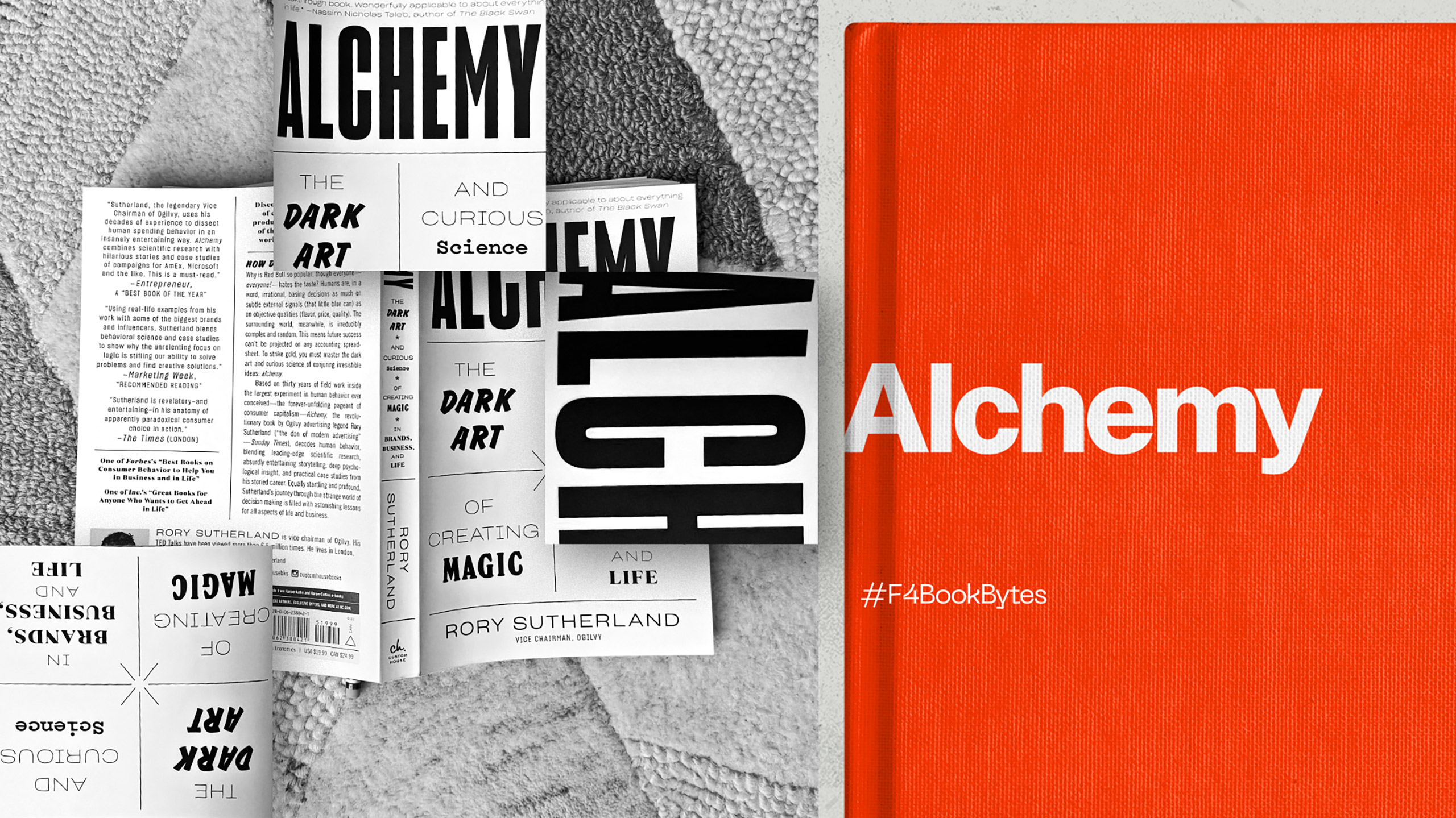Alchemy: any magical power or process of transmuting a common substance, usually of little value, into a substance of great value; a form of chemistry and speculative philosophy practiced in the Middle Ages and the Renaissance and concerned principally with discovering methods for transmuting baser metals into gold.
I recently consumed the book Alchemy: The Dark Art and Curious Science of Creating Magic in Brands, Business, and Life by Ogilvy UK advertising expert Rory Sutherland. For the first time, I was reading a complete body of work that thoroughly spoke to my approach to thinking about human behavior and decision-making as a creative and chiefly a strategist.
For years, I had intuitively operated by the behavioral psychology that Rory unpacks in this book. Now, I’ve obtained a technical vernacular to describe the magic designers can wield when the proper mixture of research, observation, and freedom is concocted.
Data and Insight (Magic Beyond Big Data)
In today’s world, “big data” is often treated as the ultimate oracle, a one-size-fits-all solution to understanding human behavior. But here’s the truth: big data alone won’t get you the magic. It’s an indispensable tool, but only part of the equation. As Rory Sutherland of Ogilvy UK argues in Alchemy, data tends to focus on what is measurable, not necessarily on what matters. “Data is like a magnifying glass: it highlights details but can miss the bigger picture.” That’s the problem. When we rely solely on data—or more recently, artificial intelligence (AI)—we’re missing the intangible human elements that truly move people.
AI, after all, is just a more advanced way of processing big data. It’s brilliant at identifying patterns, making predictions, and optimizing efficiencies. But can it truly understand the emotional quirks, irrational behaviors, or unspoken motivations of humans? Not yet. And perhaps, not ever. Magic—those moments when an idea, product, or campaign transcends the ordinary and disrupts culture—is born not from logic alone, but from creativity, intuition, and an understanding of the messy, unpredictable human psyche. Examples like the iPod, Nike’s “Just Do It” campaign or even the viral Ice Bucket Challenge didn’t come from algorithms. They were sparked by human insight, shaped by empathy, and executed with creativity.
Why Magic Needs Humans, Not Just Machines
As Sutherland emphasizes, behavioral science and psychology are at the heart of understanding people—not statistics or cold calculations. AI and big data can show us trends and averages, but they struggle to interpret the nuances of human behavior. For instance, consider the power of rebranding. In Alchemy, Sutherland recounts how renaming the Patagonian toothfish (too unsettling to link to) to “Chilean sea bass” transformed an unappealing invasive species into a high-end culinary staple. Could AI have come up with that? Likely not, because it doesn’t have the psychological awareness to understand how language and perception shape human decisions.
Or take his insight on flowers: “Flowers are just a kind of weed with a marketing and branding budget.”
To AI, a flower is just a plant, tied to familiar clichés—love, apology, celebration, mourning. To humans, however, a flower carries layers of meaning, shaped by culture, context, and emotion, capable of telling a deeply nuanced story. That distinction is profound. It’s the kind of psychological reframing that drives societal shifts and creates cultural moments. And it requires the kind of creative, empathetic, and weirdly intuitive thinking that only humans bring to the table.
The problem with AI and big data is that they are designed to optimize for what already exists. They’re brilliant at following the rules but not at breaking them. As Sutherland puts it, “The human brain is not a logic engine, it is a suggestion engine.” Magic happens in the gray areas—where irrationality, intuition, and creativity collide. Weird people, or “nerds” as my peer at Fifteen4 coined it—those who see the cracks in convention and aren’t afraid to challenge the status quo—are the ones who create the kind of disruptive, society-shifting ideas that big data can’t anticipate.
Creativity and Psychology: The Irreplaceable Edge
The lesson here isn’t to dismiss big data or AI. They’re incredibly valuable tools, but tools nonetheless. The true magic lies in how those tools are wielded. Big data can tell us what is happening but not why. AI can suggest a solution, but it can’t inspire or create a novel vision. That’s where human analysts, strategists, and creatives step in. By blending data-driven insights with a deep understanding of psychology and emotional nuance, we can craft experiences that resonate on a profoundly human level.
In a world increasingly dominated by technology, it’s easy to forget that humans are still the ultimate X factor. As Sutherland’s stories show (sometimes hilariously), the most remarkable ideas often come from the weirdest people—those who embrace the irrational, challenge the conventional, and dare to imagine what a com-pooter [insert robot sounds: beep, boop, bop] never could. So, while AI and big data may be the foundation, it’s the human touch that brings the magic to life.
Alchemy: The Dark Art and Curious Science of Creating Magic in Brands, Business, and Life
by Rory Sutherland
Barnes & Noble | Amazon | Audible | Apple Books | Spotify | GoodReads

Meet blog author Christina Melito,
Creative Director of Design + Digital
Read her bio here
#F4BookBytes
Our team compresses the wisdom and actionable inspiration gleaned from a variety of professional and creative books into bite-sized chunks as they pertain to the business, marketing, and communication challenges our colleagues and clients face.

